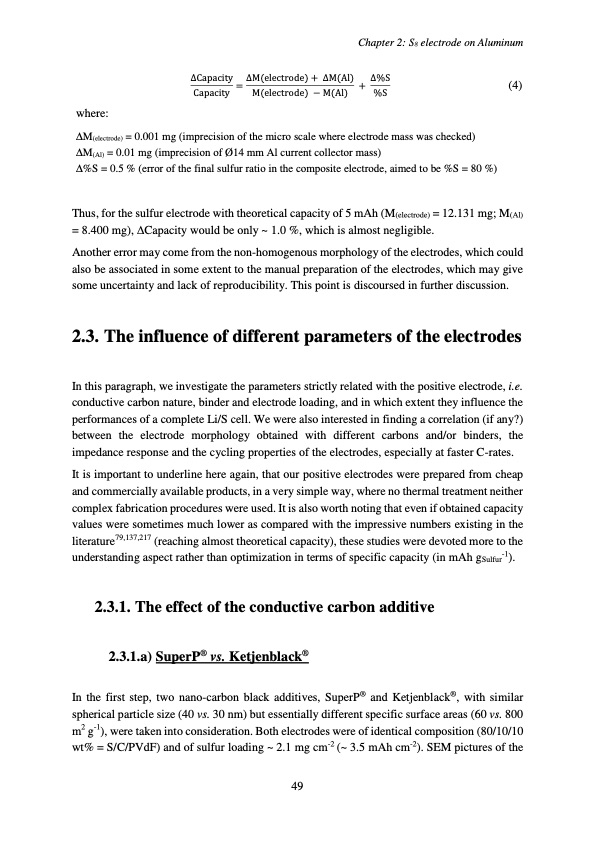
PDF Publication Title:
Text from PDF Page: 053
where: ∆Capacity = ∆M(electrode) + ∆M(Al) + ∆%S (4) Capacity M(electrode) − M(Al) %S ∆M(electrode) = 0.001 mg (imprecision of the micro scale where electrode mass was checked) ∆M(Al) = 0.01 mg (imprecision of Ø14 mm Al current collector mass) ∆%S = 0.5 % (error of the final sulfur ratio in the composite electrode, aimed to be %S = 80 %) Thus, for the sulfur electrode with theoretical capacity of 5 mAh (M(electrode) = 12.131 mg; M(Al) = 8.400 mg), ∆Capacity would be only ~ 1.0 %, which is almost negligible. Another error may come from the non-homogenous morphology of the electrodes, which could also be associated in some extent to the manual preparation of the electrodes, which may give some uncertainty and lack of reproducibility. This point is discoursed in further discussion. 2.3. The influence of different parameters of the electrodes In this paragraph, we investigate the parameters strictly related with the positive electrode, i.e. conductive carbon nature, binder and electrode loading, and in which extent they influence the performances of a complete Li/S cell. We were also interested in finding a correlation (if any?) between the electrode morphology obtained with different carbons and/or binders, the impedance response and the cycling properties of the electrodes, especially at faster C-rates. It is important to underline here again, that our positive electrodes were prepared from cheap and commercially available products, in a very simple way, where no thermal treatment neither complex fabrication procedures were used. It is also worth noting that even if obtained capacity values were sometimes much lower as compared with the impressive numbers existing in the literature79,137,217 (reaching almost theoretical capacity), these studies were devoted more to the understanding aspect rather than optimization in terms of specific capacity (in mAh gSulfur-1). 2.3.1. The effect of the conductive carbon additive 2.3.1.a) SuperP® vs. Ketjenblack® In the first step, two nano-carbon black additives, SuperP® and Ketjenblack®, with similar spherical particle size (40 vs. 30 nm) but essentially different specific surface areas (60 vs. 800 m2 g-1), were taken into consideration. Both electrodes were of identical composition (80/10/10 wt% = S/C/PVdF) and of sulfur loading ~ 2.1 mg cm-2 (~ 3.5 mAh cm-2). SEM pictures of the Chapter 2: S8 electrode on Aluminum 49PDF Image | Accumulateur Lithium Soufre

PDF Search Title:
Accumulateur Lithium SoufreOriginal File Name Searched:
WALUS_2015_archivage.pdfDIY PDF Search: Google It | Yahoo | Bing
Sulfur Deposition on Carbon Nanofibers using Supercritical CO2 Sulfur Deposition on Carbon Nanofibers using Supercritical CO2. Gamma sulfur also known as mother of pearl sulfur and nacreous sulfur... More Info
CO2 Organic Rankine Cycle Experimenter Platform The supercritical CO2 phase change system is both a heat pump and organic rankine cycle which can be used for those purposes and as a supercritical extractor for advanced subcritical and supercritical extraction technology. Uses include producing nanoparticles, precious metal CO2 extraction, lithium battery recycling, and other applications... More Info
| CONTACT TEL: 608-238-6001 Email: greg@infinityturbine.com | RSS | AMP |